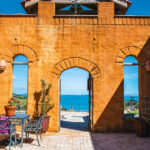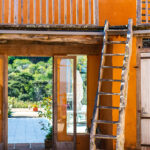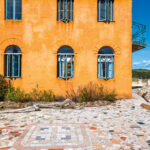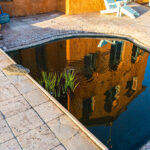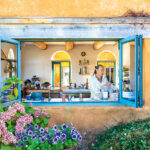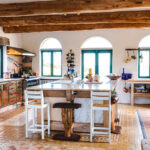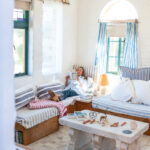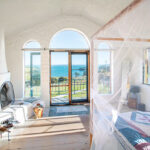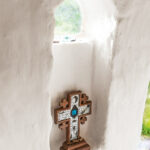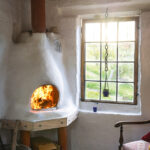The painter and casale-maker: Waiheke artist Gabriella Lewenz and husband Claude live to bring beauty to the world
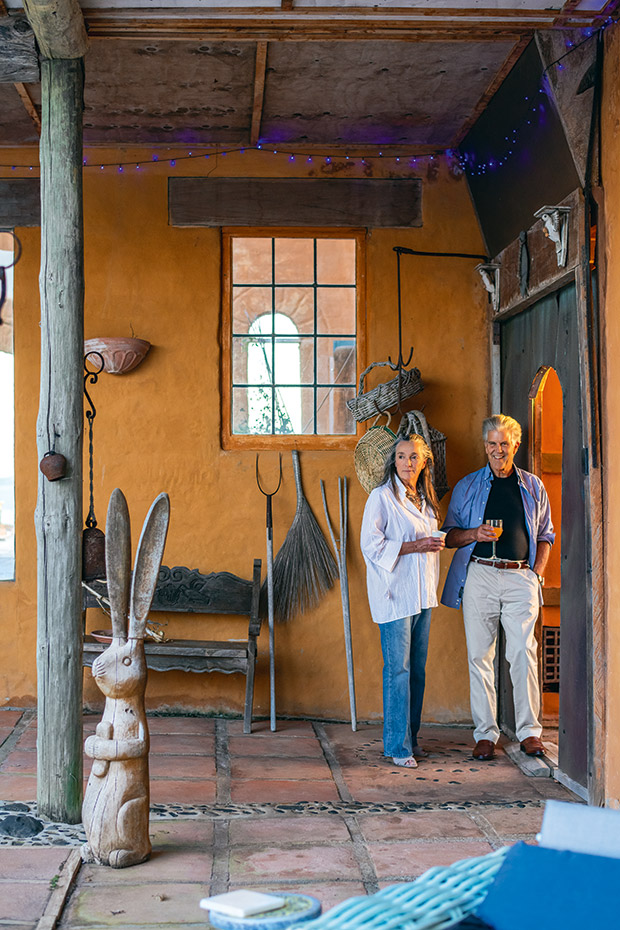
Gabriella and Claude Lewenz in the courtyard within their Italianate-style casale on Waiheke Island. The wooden rabbit once owned by Gabriella’s late mother used to stand guard in her desert garden in Arizona.
She is an artist, he has grand ideas; a couple so enamoured with bringing beauty to the world has transformed a Waiheke hillside into an earth-brick masterpiece.
Words: Cari Johnson Photos: Sonja Read
As the adage goes, when in Rome, do as the Romans do. It’s easy to imagine the Romans smiling down on this Mediterranean-like abode on Waiheke Island, where American couple Gabriella and Claude Lewenz have carried out, well, at least half of the proverb.
The long-time islanders are aware that their terracotta Italianate country house overlooking Church Bay bears little resemblance to any building on Waiheke. The four-building casale, designed by Claude, is rumoured to be the largest earth-brick structure in the country. Instead of a lounge, there’s a marble courtyard, a most fitting space for Gabriella and Claude to sip wine and dream up ways to beautify the world further. Do as the Romans do, indeed.
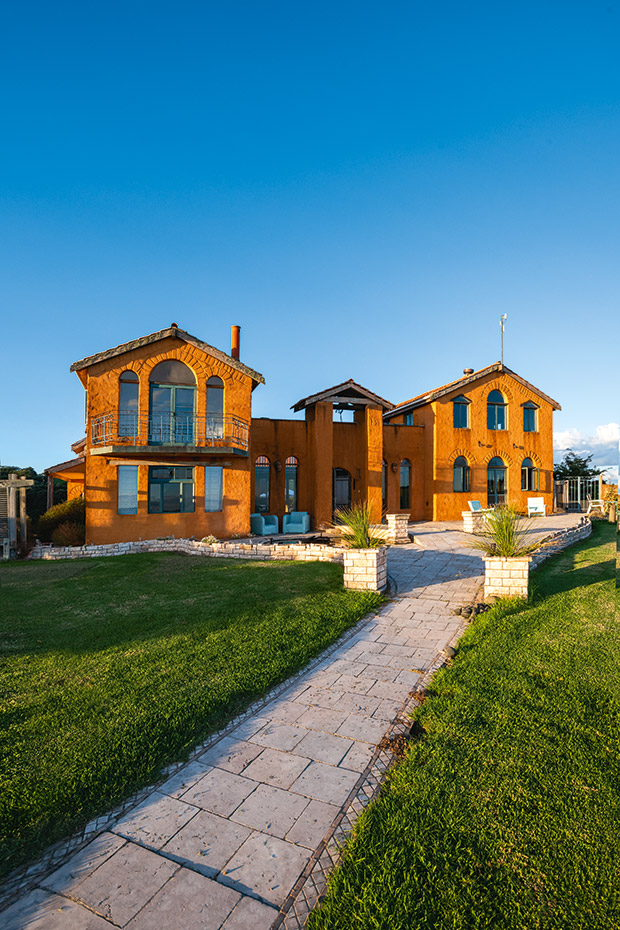
Their 283-square-metre home, Casale di Terra, is named after the earth they used to construct it. Casale, Italian for farmhouse, comes from the Latin word for “cluster of houses”, casalis. Gabriella originally wanted a small Irish cottage by the sea. However, Waiheke’s subtropical climate dictated a Mediterranean design. Claude drew up plans based on the Roman ruins of France’s Vaison-la-Romaine, where high walls shelter sun-lit courtyards.
Greece-born Gabriella, an abstract painter, immediately felt at home among Church Bay’s rolling hills, breathing in its briny air. She grew up in Athens, where her American father worked as a cultural attaché, spending her childhood in places of beauty, or mingling with those who created it — poets, playwrights, sculptors and the like. By 12, Gabriella had picked up a paintbrush to begin creating herself.
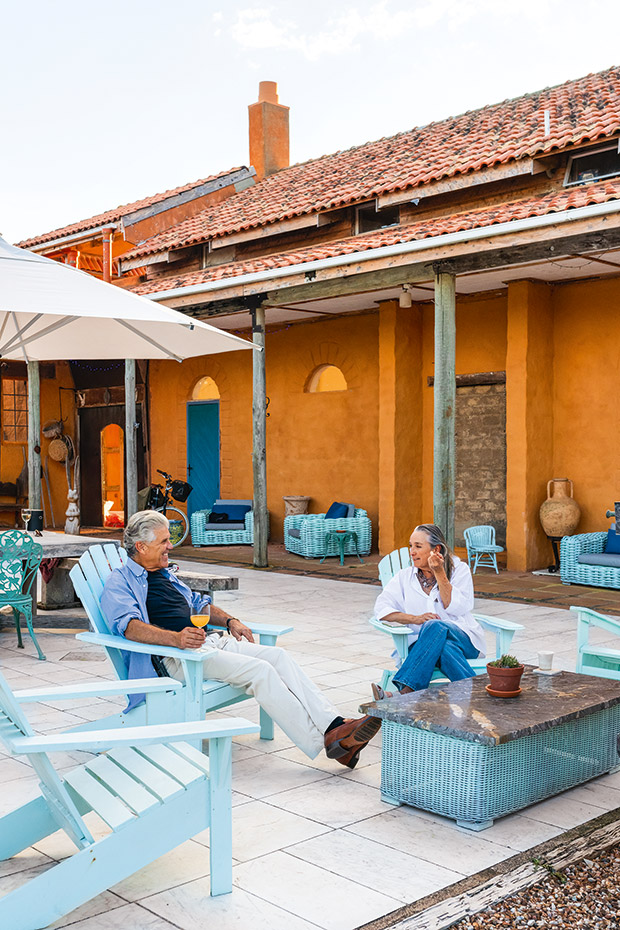
Proper shelter is a must to protect against Waiheke’s strong south-westerlies. Local expert Vince Ogletree inspired the couple to use earth bricks rather than stone. Claude made aesthetic decisions on the details daily during the build, meaning the home grew into a four-building compound. The result — a two-storey casale — eventually got Gabriella’s tick of approval for being reminiscent of the thick-walled stone houses with which she grew up in Greece.
The pursuit of beauty often emboldens Gabriella and Claude to take risks — and blaze a trail. In the 1990s, they were living in Connecticut with two-year-old daughter Micaela when they began searching for a picturesque hillside property overlooking the sea. Both had itchy feet and felt America’s “golden days” — in terms of character and infrastructure — were a thing of the past. So, when Claude learned of a faraway Antipodean island nation called New Zealand, they applied for residency, sold their home, and bought one-way tickets.
Left behind was Claude’s portfolio of software companies that took 15 years to build. For Gabriella, the move meant pulling out of high-profile galleries around Boston, New York and Connecticut. Friends and family thought they were mad. “Leaving the United States took a lot of soul-searching for what we value. It wasn’t feeding us anymore, and something was stirring in our hearts. We decided we valued beauty, as well as a lifestyle slowed down a couple of notches,” says Gabriella.
- Dangling atop the bell-tower portico is a 19th-century church bell from Scotland. Getting the bell to Aotearoa was a mission and a half, involving a three-year waitlist, a mad dash across borders and international media attention. The “doorbell” in the bell tower pays homage to the Anglican Māori church that gave Church Bay its name. ‘Hangaura’, the Māori name for Church Bay, is engraved in stone at the entrance.
- Claude’s “commute” from the kitchen to his office involves scrambling up a ladder; building materials are unlikely to be wasted under Claude’s watch.
- A local chemist, originally from the Czech Republic, helped him with finishing touches on the home for years and used a pile of leftover stone to tile the terrazzo.
- A goldfish called Frederick resided in the entrance’s pond for about 20 years before dying of old age.
Today, art collectors who visit their home, named Casale di Terra (Italian for “country house made of earth”), reaffirm there’s beauty aplenty in this corner of Hauraki Gulf. Sure, there’s natural beauty, such as Gabriella’s bee-friendly veggie garden and a vista with every blue hue on the spectrum. However, most of the beauty comes from Gabriella’s unbridled imagination and shelves of Williamsburg oil paints.
Whether natural or manufactured, her surroundings tend to sneak into her large-scale oil paintings. A 2000-year-old Greek amphora inherited from her father, which sits in their kitchen-cum-dining-room, appears in her paintings in feminine curves or the shape of a belly. Colour, too, makes Gabriella’s sense of place almost tangible.
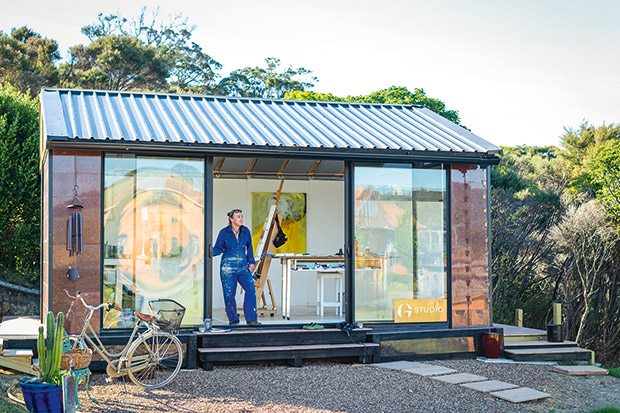
Gabriella’s studio is located across the paddock, where she can paint for hours given a good podcast and paintbrush.
“My paintings were monochromatic when we lived on the East Coast of the US — full of greys, blacks and gradation. I’ve become a colour-field painter since moving to Waiheke. I am bold with colour in a mindful and delicate way.
“There’s an elemental aspect to why and how I work. It’s not just beautiful reds and yellows coming together to create these abstract colour fields, I hope to reveal something much deeper and to invite the viewer to experience that.”
When she and Claude first arrived at Waiheke, Gabriella decided to sell her art without gallery representation. The question was, would the art scene be able to find her here? It turns out travelers had a hard time ignoring the Tuscan-orange casale poking up on the horizon while imbibing at nearby wineries Mudbrick and Cable Bay. Curiosity led to phone calls, then private appointments and international bookings. Word of Gabriella Lewenz’s paintings eventually permeated art circles throughout Europe, the United States and Asia. Before long, she’d amassed a global following that made up 90 per cent of her clientele.
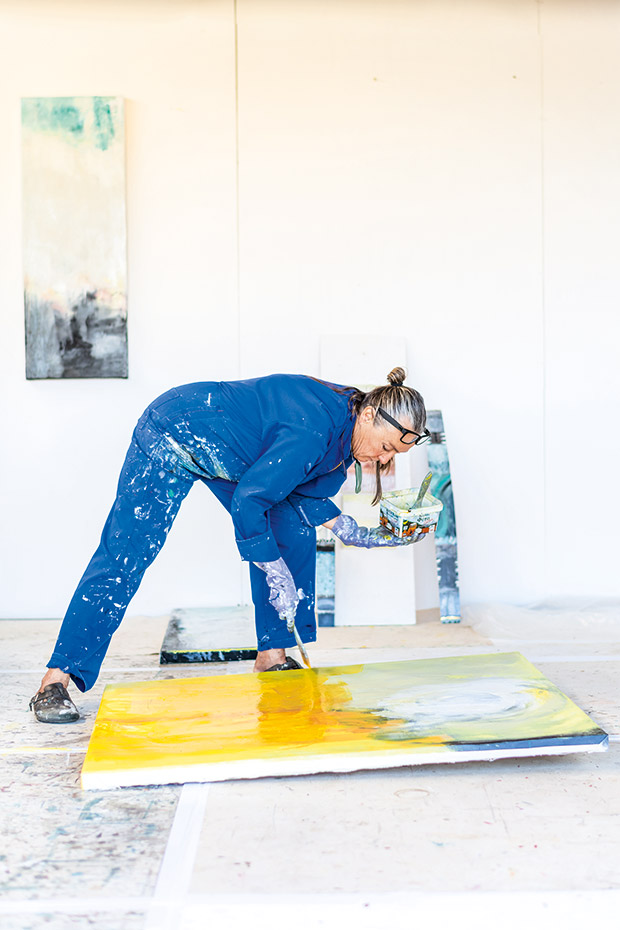
Layered colour and texture are hallmarks of Gabriella’s ethereal abstract colour scapes, which subtly hint at the backdrop that is her and Claude’s home. This artistic magic takes weeks, maybe months, to manifest on canvas.
Everything was just peachy until March 2020, when the murmurings of a certain pandemic came true overnight. “Literally in 24 hours, we had phone calls canceling everything,” recalls Claude. “We looked at each other and went, ‘Hmm, we have a problem here.’”
Setbacks have seldom stopped the couple from forging ahead. When they began dating in the 1980s, Claude didn’t think twice about renovating Gabriella’s carriage house himself, after phoning her landlord beforehand to get the okay. Out went the linoleum floors, and in went glossy planks of timber. His new girlfriend was so impressed that she ended up marrying him. “In New Zealand, people do things themselves, so I fit right in,” says Claude.
- With no formal dining room or lounge, the marble-slab kitchen table is the beating heart of the Lewenz household. Olive oil pressed from their trees is used in much of Gabriella’s cooking.
- Claude sourced copper sheets damaged in shipping for the kitchen cabinets. The beam outside of the kitchen window was originally a transformer cross-arm Claude salvaged from the local power company.
So, in true Aotearoan spirit, the Lewenzes of Waiheke hatched a DIY plan to tackle the whole closed-border conundrum. Claude would convert Gabriella’s studio into a gallery to showcase her work and that of other Kiwi artists. “People are willing to travel for art. Church Bay, which has a European feel, feels like Provence or Umbria. Go to Oneroa, and suddenly it feels like Kauai. I find it amazing about New Zealand — it’s so small to have such variety. We figured that adding a first-class gallery would add one more thing to the Waiheke experience,” he says.
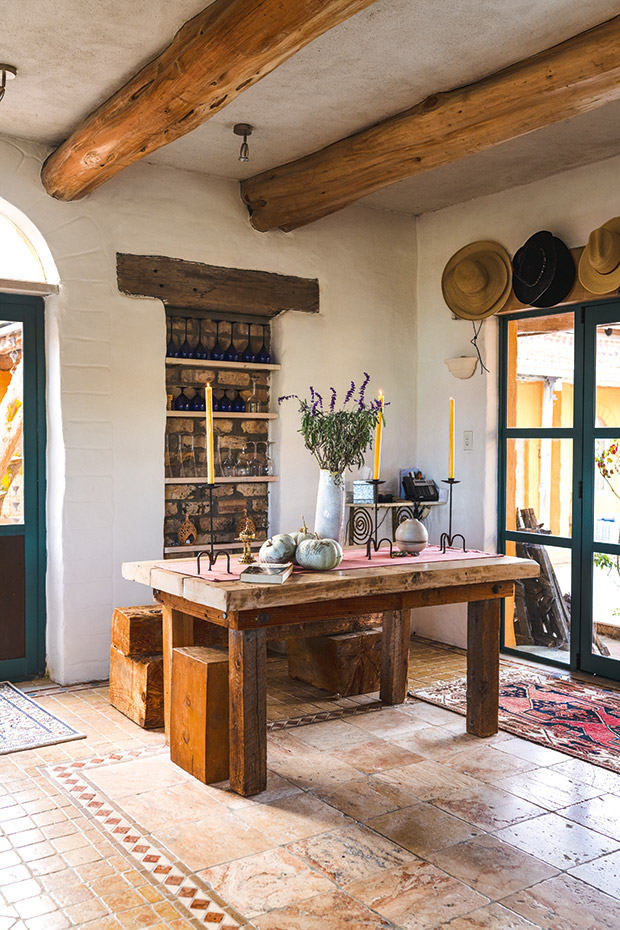
Back in the United States, in preparation for a party, the couple realized they needed a dining table that evening. While Gabriella cooked, Claude built a table from wood reclaimed from a 17th-century home in New England.
No matter that ferries and borders were shut or that, in terms of materials, they had only what lay around on their property. Upcycling-keen Claude has creativity in spades. “Using beautiful, recycled things — or things that don’t cost a lot — has enabled us to create a lifestyle that is unique. For example, right now, I have 20 pallets of unwanted stone — marble, granite and sandstone I got for $1000 all up. We decided a long time ago only to do what we could afford — using resources creatively and not involving banks,” he says.
After two years in the making, Gabriella’s new gallery opened in early 2022 with an inaugural collaboration with Auckland’s Whitespace Contemporary art dealer featuring interdisciplinary artist Lianne Edwards and Māori sculptor Anton Forde. The future of the new space is like looking at a blank canvas — unknown and exciting. Rarely can Gabriella imagine what a finished painting will look like before it gets its first layer of pigment. “My craft is truly about being in the moment, which navigates the painting from start to finish. It starts off raw, and then something happens where the painting calls back to me,” she says.
- Gabriella’s reading room/office is lined with swamp kauri thought to be at least 30,000 years old. It took four men to get the table, made of Vermont marble, into the room. “And it will never move again,” says Claude.
- The walls of the casale, including their bedroom, were whitewashed for a Mediterranean-inspired look.
- A Mexican milagro cross gifted from Gabriella’s mother sits in a prayer window built specifically for the relic.
And while she paints, what does Claude do? “I create,” he says. The entrepreneurial spirit usually has his thumb in some environmental or social project, the most recent being a housing initiative for Waiheke beneficiaries. “We’ve positioned ourselves to be able to do things like that. As Gabriella has eliminated gallery pressures and deadlines, I’m no longer on the hamster wheel. So, if she needs to spend a week in the garden, she spends a week in the garden,” he says.
With 25 years of residence and counting, the painter and casale-maker are bona fide locals. The life they’ve designed on this hillside is a bit classical, Roman-esque even. But it’s also a bit Greek, French, American — and very Waihekian in spirit.
- To avoid sending construction waste to the tip, the 10-square-metre writer’s hut, a short distance from the house, used all the remaining earth bricks and other materials left over from construction. The hut was built by a Norwegian friend keen to have a go at building a tiny house (“before they became fashionable” says Claude).
- Several writers can attest that a few days or weeks in the small hut works magic for writer’s block. The portrait of a young Native American girl was owned by Gabriella’s mother.
“They say the people you meet in France and Germany will be much different to the French and Germans you meet while traveling. Travelers tend to be bolder and more open. As for Waiheke, most people here were born somewhere else,” says Claude.
Adds Gabriella: “That’s what we love about it — the diversity of backgrounds on the island, culturally and economically, all mingling together as one community.”
WHY WAIHEKE?
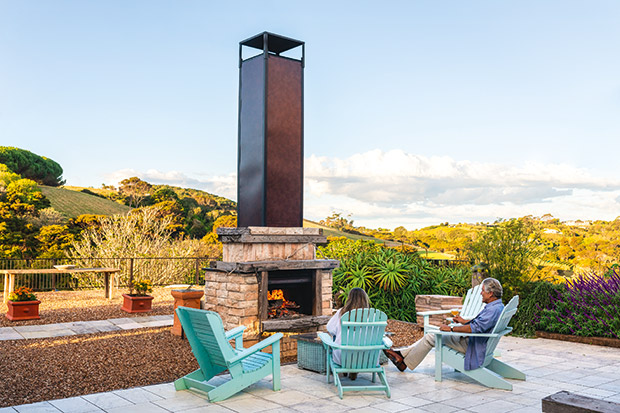
In their move Down Under, Claude and Gabriella had initially bought land in Christchurch to fulfil the property requirement for their visa. But Gabriella sought something specific — well, three specifics — for their forever hillside.
It needed a coastal landscape much like Ireland’s Slea Head, have good coffee in a nearby village and be close to a large city.
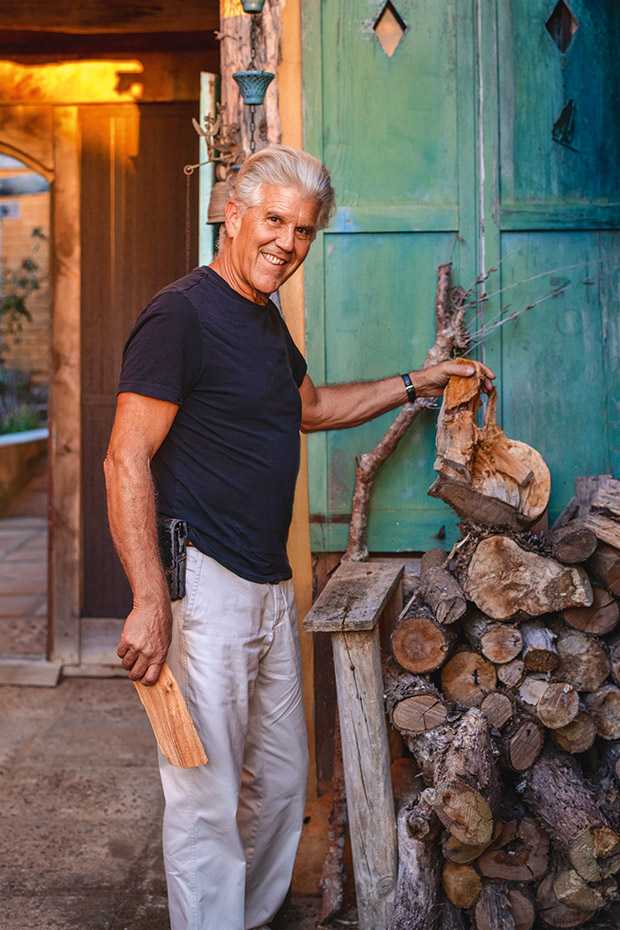
Give Claude some leftover rose quartz, and he may build a north-facing fireplace. “What I do with paint, Claude does with materials,” says Gabriella. “He takes it day by day and designs as he goes.” Come autumn and winter, the courtyard above (one of two) is the warmest place to watch the sunlight cast its glow on Church Bay.
“Those were my marching orders,” says Claude, who ended up on a solo scouting mission throughout New Zealand just before their intercontinental move. “Everyone I talked to told me her vision was of Church Bay on Waiheke.”
THE BIG PICTURE
Gabriella Lewenz commutes by bicycle to her studio across the paddock, where she can paint for hours given a good podcast and paintbrush. She flies from one canvas to the next, layering here and dappling there, directing her creative energy towards whichever project calls to her.
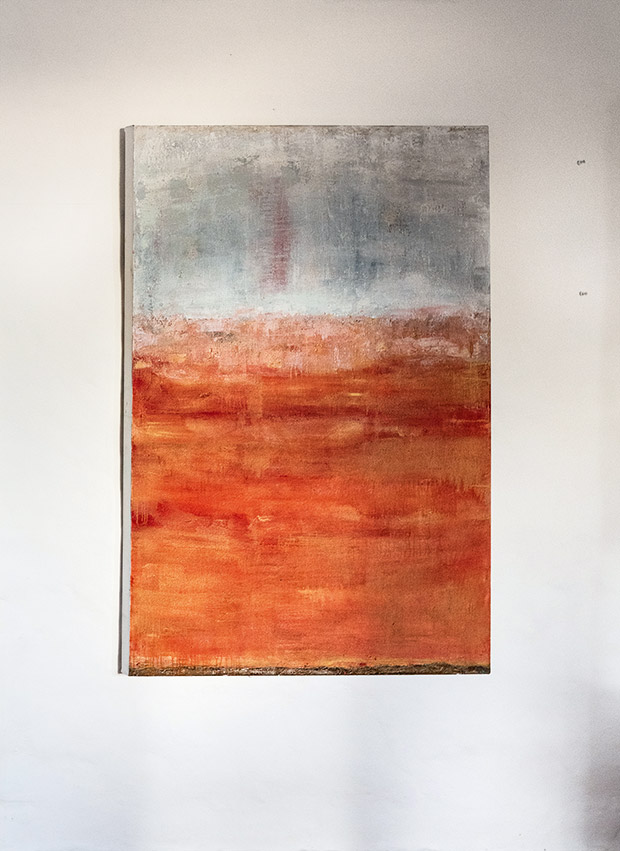
“It’s not about getting stuck but knowing when to let a piece rest and start something new. By doing something else, I can resolve the first piece. Even if a painting isn’t going in the right direction, I can always resurrect it,” Gabriella says, adding that she turns to doodling when all else fails.
Layered colour and texture are hallmarks of her ethereal abstract colour scapes, which subtly hint at the backdrop that is her and Claude’s home. This artistic magic takes weeks, maybe months, to manifest on canvas. It can also require the studio to act as a laboratory — Gabriella grinding ash, stone, charcoal or marble dust in her mortar and pestle to make pigments.
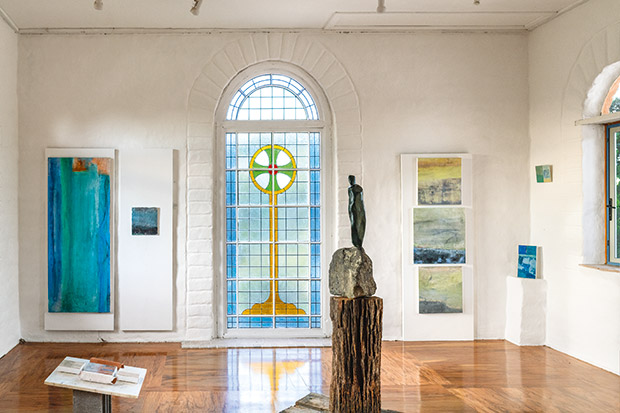
Gabriella’s new gallery was inspired by the (now closed) Vivian Gallery in Matakana and the galleries of rural Europe. The sculpture Mōhio — Knowledge, Wisdom is by Waiheke artist Anton Forde, represented by Whitespace Contemporary Art.
“Mixing minerals into the pigment gives a beautiful layering to a painting. I put leftover paint back into tubs and mix it with linseed and recycled turpentine, which creates that viscous layering effect you’ll often find on my surfaces,” she says.
Website: lewenz.net / Instagram: @gabriellalewenzart
Love this story? Subscribe now!
 This article first appeared in NZ Life & Leisure Magazine.
This article first appeared in NZ Life & Leisure Magazine.
